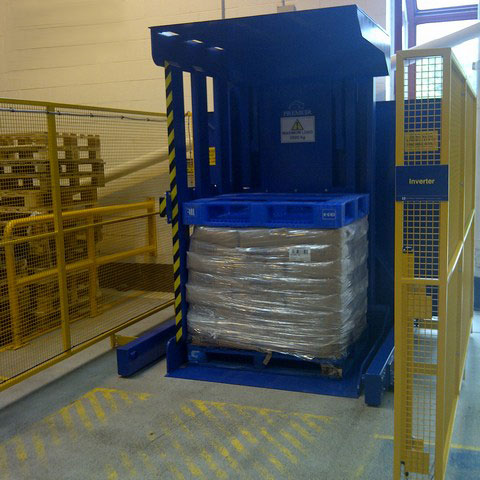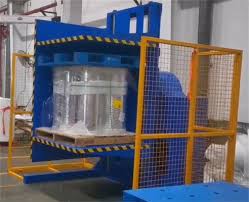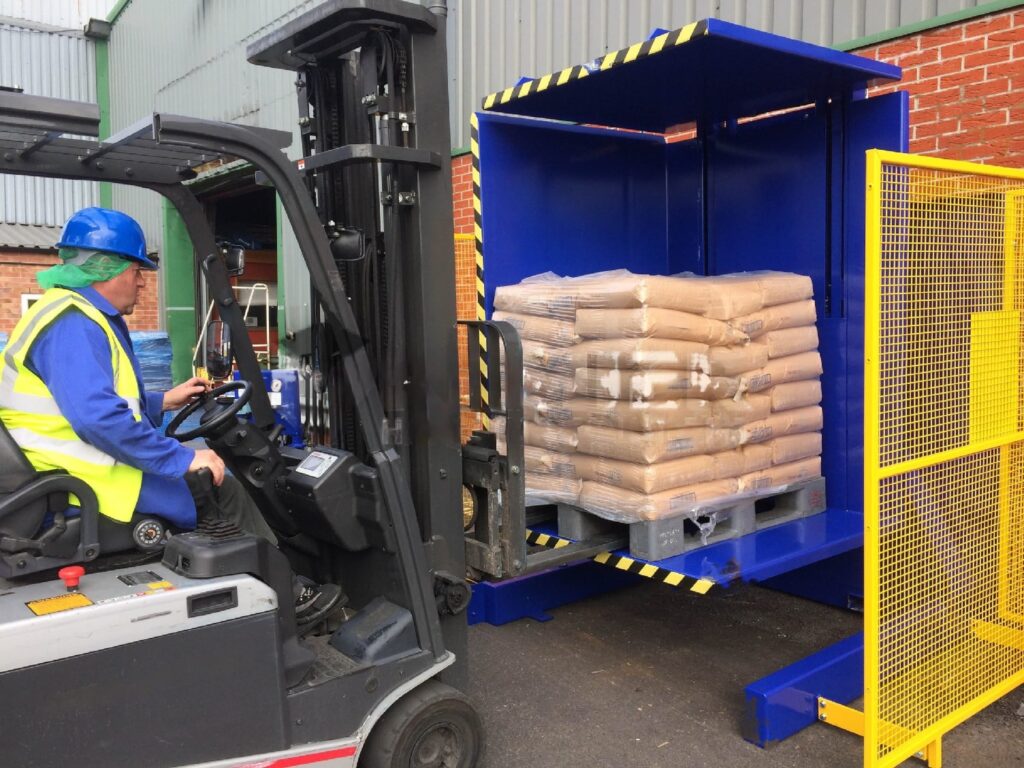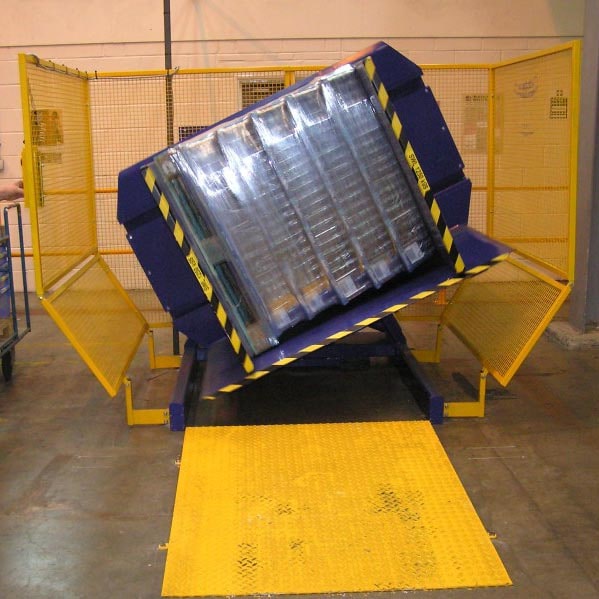How Pallet Inverters Solve and Reduce Manual Strain in Coffee and Fruit Logistics in Colombia?
Handling heavy goods like coffee sacks and fruit crates in Colombia is tough work. Day after day, workers manually lift, carry, and stack these heavy loads. This repetitive strain is a major problem. It leads to worker injuries, high employee turnover, and slower operations. For any logistics or factory manager, this is a constant source of stress and inefficiency. What if you could remove this physical burden completely? There is a powerful mechanical solution that automates this hard work and protects your team.
A pallet inverter directly solves manual strain in logistics by automating the process of transferring goods from one pallet to another. The machine securely clamps the entire load, rotates it, and allows for a quick pallet exchange without any manual lifting of individual items. This technology protects workers in the Colombian coffee and fruit industries from injury, reduces product damage, and significantly speeds up the entire handling process.

I have spent my entire career in the packing machine industry. I started as an engineer on the factory floor and eventually built my own company, SHJLPACK. I understand the real-world challenges of moving heavy products efficiently and safely. The problems in a steel mill are not so different from those in a coffee processing plant. Both involve heavy materials, the need for speed, and the risk of injury to workers. It is critical to understand the specific tasks that cause strain to see how the right equipment can provide a total solution. Let's look deeper into the challenges in Colombia's agricultural logistics and how pallet inverters offer a clear path to improvement.
What specific manual handling tasks in Colombian coffee and fruit logistics lead to the most strain and injuries?
Imagine a worker in a Colombian warehouse. Their job is to move 70-kilogram coffee sacks from a wooden pallet to a plastic one for export. They do this all day long. This is not just tiring work; it is a serious health and safety risk. The constant physical stress leads to back problems, muscle tears, and other injuries that can end a person's career. This is a huge problem for both the worker and the company. The solution is to find a way to do the job without the worker having to lift the weight themselves.
The most straining tasks in Colombian coffee and fruit logistics are the manual transfer of goods between pallets. This happens when switching to export-grade pallets, replacing damaged pallets, or performing quality control checks. These tasks require workers to repetitively bend, lift heavy sacks or crates, and twist their bodies, which are the primary causes of musculoskeletal injuries.

In my experience designing and building packing equipment, the first step is always to analyze the workflow in detail. We must pinpoint the exact moments where strain, inefficiency, or risk occurs. In the coffee and fruit supply chain in Colombia, these moments are frequent and easy to identify. The problem is not just about lifting; it is about how the lifting is done and how often. A deep look shows three main areas where manual handling creates significant problems. These are the core issues that automation, like a pallet inverter, is designed to solve completely.
The Dangers of Repetitive Lifting
The most obvious challenge is the weight. A single sack of Colombian coffee can weigh between 50 and 70 kilograms. A crate of fruit can also be heavy and awkward to handle. A worker might be required to move an entire pallet's worth of these items, one by one. This means they could be lifting a total of 1,000 to 1,500 kilograms per pallet. If they process 10 or 20 pallets in a shift, the cumulative weight lifted is enormous. This repetitive strain on the muscles and spine is a direct cause of long-term injuries. The human body is not designed for this kind of repetitive, heavy labor. Over time, it leads to chronic pain, reduced mobility, and frequent absences from work. This directly impacts the productivity and morale of the entire team.
Awkward Postures and Movements
The problem gets worse because of the movements required. Workers often have to bend down to pick up a sack from the bottom of a pallet. Then they have to lift it while twisting their body to place it on the new pallet. This combination of bending and twisting under a heavy load is one of the most dangerous movements for the human back. It puts immense pressure on the spinal discs and supporting muscles. Furthermore, reaching across a pallet to place items in the middle requires workers to extend their bodies in an unbalanced posture. This increases the risk of losing balance, dropping the product, and injuring themselves or others. These are not isolated incidents. They are built-in risks of the manual handling process.
The Hidden Costs of Manual Strain
The direct costs of injuries, like medical bills and compensation claims, are clear. But there are many hidden costs that also impact the business's bottom line. High injury rates lead to high employee turnover. It is difficult to keep skilled and motivated workers in a job that is physically painful and dangerous. This means companies face constant costs for recruiting and training new employees. Productivity also suffers. A tired or injured worker moves slower. The quality of their work can drop, leading to damaged products. The table below breaks down the impact clearly.
| Factor | Manual Pallet Transfer | Pallet Inverter Transfer |
|---|---|---|
| Injury Risk | High (back, shoulder, knee strain) | Near Zero (operator pushes buttons) |
| Task Time | 20-30 minutes per pallet | 2-5 minutes per pallet |
| Worker Fatigue | High, reduces productivity over shift | Low, consistent performance all day |
| Product Damage | Higher risk from dropping or mishandling | Minimal, load is securely clamped |
| Hidden Costs | High turnover, insurance, training costs | Low, stable workforce, predictable costs |
How does a pallet inverter's mechanism directly reduce physical stress on workers compared to manual methods?
You see your workers struggling with heavy loads. You know the risk of injury is high and that it slows down your entire operation. You want to fix this, but how exactly does a machine like a pallet inverter solve the problem? It might seem like a complex piece of equipment, but its function is straightforward. It is designed to do one thing perfectly: take the physical load off your workers and put it onto a powerful, reliable machine.
A pallet inverter reduces physical stress by completely eliminating manual lifting during pallet transfers. Its mechanism uses hydraulic or electric power to securely clamp the entire pallet load, rotate it 180 degrees, and lower it gently. This allows the operator to simply remove the old pallet from the top and place a new one. The entire process is controlled from a safe distance with push buttons, removing all bending, lifting, and twisting.

When I was an engineer, my focus was always on creating simple solutions to complex problems. A good machine should be easy to understand and use. The pallet inverter is a perfect example of this principle. It replaces a dangerous, multi-step manual process with a simple, automated one. To truly appreciate its impact, it is helpful to break down how the machine works and compare it directly to the old way of doing things. The difference is not just about speed; it is about a fundamental change in how the work is done, making it safer and more efficient.
The Core Mechanism: Clamp, Rotate, Exchange
The power of a pallet inverter comes from its simple and robust design. Here is how it works. First, a forklift places the entire loaded pallet into the inverter's loading bay. The operator then presses a button. Two strong, padded clamps move in from the sides and top, securing the entire load of coffee sacks or fruit crates. The pressure is carefully controlled to hold everything firmly without causing damage. Once the load is secure, the machine's rotation system smoothly turns the entire platform a full 180 degrees. The original pallet is now on top, separated from the goods. The operator can easily lift it off with a forklift. A new pallet is then placed on top of the inverted load. The machine rotates back 180 degrees, and the forklift removes the newly palletized goods. The entire task is completed without a single item being lifted by hand.
From Physical Labor to Machine Operation
The biggest change is the worker's role. With manual methods, the worker is the machine. Their body provides the power and movement. With a pallet inverter, the worker becomes an operator. They are no longer a source of physical labor but a controller of an efficient process. Their job shifts from physically demanding to mentally focused. They are responsible for overseeing the machine's operation, ensuring safety, and managing the flow of goods. This not only eliminates the risk of physical strain but also elevates the nature of the job. It allows you to retain skilled workers who can manage automated systems, which is a more valuable skill in a modern logistics environment.
A Direct Comparison of Workflows
The best way to see the difference is to compare the steps involved. The contrast highlights the enormous benefits in safety and efficiency that a pallet inverter provides.
| Step | Manual Pallet Transfer (One Worker) | Pallet Inverter Transfer (One Operator) |
|---|---|---|
| 1 | Bend down and lift a 70kg coffee sack. | Forklift places the full pallet into the inverter. |
| 2 | Twist body and place sack on new pallet. | Operator presses the 'Clamp' and 'Rotate' buttons. |
| 3 | Repeat step 1 and 2 for all sacks (20+ times). | Forklift removes the old pallet from the top. |
| 4 | Restack sacks carefully to ensure stability. | Forklift places the new pallet on the inverted load. |
| 5 | Manually clean up any spilled product. | Operator presses the 'Rotate Back' button. |
| 6 | Take a rest break due to physical fatigue. | Forklift removes the finished pallet, ready to go. |
This comparison makes it clear. The manual process is slow, dangerous, and inconsistent. The automated process is fast, safe, and highly repeatable. It transforms a major operational bottleneck into a smooth and efficient part of your workflow.
What are the long-term economic benefits of implementing pallet inverters in the Colombian agricultural supply chain?
Buying a new machine is a significant investment. As a factory owner, I analyze every major purchase very carefully. The first question is always: "Will this machine make us more money?" An expense is just a cost, but a good investment provides a clear return. For pallet inverters, the economic benefits are not just theoretical. They are real, measurable, and they accumulate over the long term, making your entire operation stronger and more profitable.
The long-term economic benefits of implementing pallet inverters are significant. They include major cost savings from eliminating workplace injury claims, a dramatic increase in operational throughput and efficiency, reduced labor costs due to higher productivity, and less product loss from damage during handling. These factors combine to deliver a strong return on investment (ROI) and a more competitive supply chain.

When I help clients choose equipment, I encourage them to think beyond the initial price tag. We need to look at the Total Cost of Ownership (TCO) and the overall impact on the business. A pallet inverter is a perfect case study for this approach. Its value is not just in the machine itself, but in the problems it solves and the opportunities it creates. The economic case becomes very clear when you break down the different ways it saves and earns you money over many years of operation.
Direct Cost Reductions
The most immediate economic benefit comes from cost reduction. Workplace injuries are incredibly expensive. There are direct costs like medical treatment and insurance premium increases. There are also indirect costs like lost productivity, the cost of hiring and training replacements, and potential legal fees. By eliminating the manual handling that causes these injuries, a pallet inverter directly attacks these costs. One avoided back injury claim could pay for a significant portion of the machine's cost. Furthermore, a pallet inverter reduces product damage. Manual handling can lead to dropped sacks or crushed fruit crates. The secure clamping mechanism of an inverter protects the product, reducing waste and preserving its value. This is a direct saving that goes straight to your profit margin every single day.
Increased Productivity and Throughput
Time is money in logistics. The faster you can process goods, the more volume you can handle and the more revenue you can generate. A manual pallet transfer can take two workers 20-30 minutes. A pallet inverter can do the same job with one operator in just 2-5 minutes. This is a productivity increase of over 80%. This new speed means you can move more coffee or fruit through your facility without hiring more people. It allows you to meet tight shipping deadlines, respond faster to customer orders, and reduce bottlenecks that slow down your entire supply chain. Over a year, this added capacity can lead to substantial business growth.
Strategic and Market Advantages
The benefits go beyond just cost and speed. Using a pallet inverter can provide a strategic advantage in the market. Many international buyers, especially in Europe and North America, have strict requirements for pallet types. They often demand plastic or heat-treated pallets to prevent contamination or pests. A pallet inverter makes it fast and easy to switch from standard wooden warehouse pallets to high-quality export pallets. This capability can open up new, more profitable markets for Colombian coffee and fruit producers. It shows that your operation is modern, professional, and compliant with global standards. This builds trust with high-value clients and strengthens your position in a competitive global market.
| Economic Benefit Area | Impact of Pallet Inverter | Long-Term Value |
|---|---|---|
| Workplace Safety | Drastically reduces injury-related costs. | Lower insurance premiums, stable workforce. |
| Operational Speed | Increases pallet transfer speed by over 80%. | Higher throughput, ability to handle more volume. |
| Labor Efficiency | Frees up workers for more valuable tasks. | Lower labor cost per pallet, optimized staffing. |
| Product Quality | Minimizes damage during handling. | Reduced waste, higher customer satisfaction. |
| Market Access | Enables easy switching to export-grade pallets. | Access to premium markets, stronger brand image. |
Vincent's Insight: Beyond the Machine - A Partnership Approach to Logistics Automation
I have seen many companies buy machines. But I have also seen many of those machines fail to deliver the expected results. The reason is often simple. They bought a piece of hardware, but they did not get a solution. The supplier disappeared after the sale, and when a problem occurred, the factory was left on its own. This is a critical mistake. Your success depends on a partnership, not just a transaction.
My journey from an engineer to a factory owner taught me a vital lesson: the most important investment is not in a machine, but in a partner who provides a total solution. A true partner works with you to understand your specific challenges, provides the right equipment, and offers support for the long term. This ensures your investment delivers real, lasting value and helps your business grow.

I am passionate about sharing my knowledge because I am grateful for what this industry has given me. It allowed me to build a successful business and achieve financial independence. Now, my goal with SHJLPACK is to help others succeed in the same way. This means going beyond just selling equipment. It means applying my experience to help you find the right solution for your specific needs, whether you are handling steel coils in Mexico or coffee beans in Colombia. The principles of good engineering and smart business are universal.
The Engineer's View on a 'Total Solution'
I remember a difficult time early in my factory's history. I bought a key machine from a supplier who offered the lowest price. A few months later, it broke down during a critical production run. I called the supplier for help, but they offered no support. My production line was stopped for three days while I scrambled to find a local technician who could fix it. That experience was incredibly costly. It taught me that the initial price of a machine is only a small part of its true cost. The experience shaped the entire philosophy of SHJLPACK. We are not just vendors; we are engineers and problem-solvers. A 'total solution' means we are there with you from the beginning to the end. We help you with the initial analysis, the installation, the training of your operators, and the long-term maintenance. We want your machine to be a success for its entire life, not just on the day it arrives.
Matching the Right Machine to the Mission
A machine is just a tool. To be effective, it must be the right tool for the job. A business owner like Javier Morales in the steel industry has very different needs from a logistics manager in the fruit industry. Javier needs equipment that can handle extreme weights, integrate with complex production schedules, and withstand a harsh factory environment. The coffee logistics manager needs a machine that is gentle on the product, fast, and meets food-grade hygiene standards. A good partner does not offer a one-size-fits-all product. They take the time to understand the unique mission of your business. We look at your entire workflow, your business goals, and your challenges. Then, we recommend or even customize a solution that is perfectly matched to your needs. This is the difference between buying a machine and investing in a solution that drives your business forward.
Future-Proofing Your Investment
The world is changing quickly. Technology is always advancing. A smart investment today should still be valuable ten years from now. This is why a partnership approach is so important. We help our clients think about the future. For example, we discuss how a pallet inverter can be integrated into a larger automated system. We can equip our machines with sensors and connectivity for IoT platforms and Manufacturing Execution Systems (MES). This allows you to collect data, monitor performance, and even predict when maintenance is needed. For a forward-thinking leader who is focused on digitalization, this is crucial. A good partner does not just solve today's problem. They help you build a more efficient, resilient, and future-ready operation.
Conclusion
Investing in pallet inverters is not just about safety. It is about building a faster, more profitable, and resilient logistics operation for the future.




